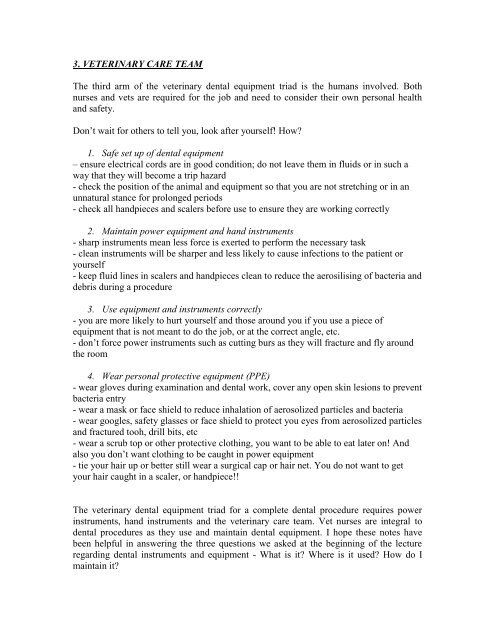Identification and Care of Veterinary Dental
Identification and Care of Veterinary Dental
Identification and Care of Veterinary Dental
You also want an ePaper? Increase the reach of your titles
YUMPU automatically turns print PDFs into web optimized ePapers that Google loves.
3. VETERINARY CARE TEAM<br />
The third arm <strong>of</strong> the veterinary dental equipment triad is the humans involved. Both<br />
nurses <strong>and</strong> vets are required for the job <strong>and</strong> need to consider their own personal health<br />
<strong>and</strong> safety.<br />
Don’t wait for others to tell you, look after yourself! How?<br />
1. Safe set up <strong>of</strong> dental equipment<br />
– ensure electrical cords are in good condition; do not leave them in fluids or in such a<br />
way that they will become a trip hazard<br />
- check the position <strong>of</strong> the animal <strong>and</strong> equipment so that you are not stretching or in an<br />
unnatural stance for prolonged periods<br />
- check all h<strong>and</strong>pieces <strong>and</strong> scalers before use to ensure they are working correctly<br />
2. Maintain power equipment <strong>and</strong> h<strong>and</strong> instruments<br />
- sharp instruments mean less force is exerted to perform the necessary task<br />
- clean instruments will be sharper <strong>and</strong> less likely to cause infections to the patient or<br />
yourself<br />
- keep fluid lines in scalers <strong>and</strong> h<strong>and</strong>pieces clean to reduce the aerosilising <strong>of</strong> bacteria <strong>and</strong><br />
debris during a procedure<br />
3. Use equipment <strong>and</strong> instruments correctly<br />
- you are more likely to hurt yourself <strong>and</strong> those around you if you use a piece <strong>of</strong><br />
equipment that is not meant to do the job, or at the correct angle, etc.<br />
- don’t force power instruments such as cutting burs as they will fracture <strong>and</strong> fly around<br />
the room<br />
4. Wear personal protective equipment (PPE)<br />
- wear gloves during examination <strong>and</strong> dental work, cover any open skin lesions to prevent<br />
bacteria entry<br />
- wear a mask or face shield to reduce inhalation <strong>of</strong> aerosolized particles <strong>and</strong> bacteria<br />
- wear googles, safety glasses or face shield to protect you eyes from aerosolized particles<br />
<strong>and</strong> fractured tooh, drill bits, etc<br />
- wear a scrub top or other protective clothing, you want to be able to eat later on! And<br />
also you don’t want clothing to be caught in power equipment<br />
- tie your hair up or better still wear a surgical cap or hair net. You do not want to get<br />
your hair caught in a scaler, or h<strong>and</strong>piece!!<br />
The veterinary dental equipment triad for a complete dental procedure requires power<br />
instruments, h<strong>and</strong> instruments <strong>and</strong> the veterinary care team. Vet nurses are integral to<br />
dental procedures as they use <strong>and</strong> maintain dental equipment. I hope these notes have<br />
been helpful in answering the three questions we asked at the beginning <strong>of</strong> the lecture<br />
regarding dental instruments <strong>and</strong> equipment - What is it? Where is it used? How do I<br />
maintain it?

















